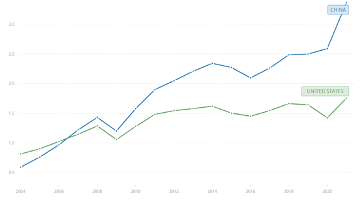Sino-American economy booms despite geopolitics
Economy 12 February 2023Estimated time of reading: ~ 2 minutes
The Administration of US President Joseph Biden has recently announced that a Chinese balloon that flew over the US was part of a military espionage program that targeted over 40 countries. A senior State Department official stated that the Chinese military utilized a fleet of balloons equipped with advanced technology to gather sensitive information globally, with these balloons having been deployed over five continents. This official provided comprehensive information linking the Chinese military to the balloon, which was shot down by US forces over the Atlantic Ocean. The US government is striving to refute China’s persistent denials that the balloon was used for spying purposes, including China’s recent claim that the accusations from the US are part of an “information warfare” against Beijing. A Chinese Foreign Ministry spokeswoman, Mao Ning, reiterated Beijing’s stance that the balloon was a civilian weather balloon that had deviated from its intended course and that its downing was an excessive reaction from the US.
The current diplomatic tensions between Washington and Beijing have been heightened by the recent incident involving the alleged spy balloon that flew over US territory and was shot down by the US military over the Atlantic. The trade of goods between the US and China in 2022 reached a record-breaking value of 642.33 billion euros, despite the strained diplomatic relations between the two nations. New data shows that the US imported goods from China with a value of 499.51 billion euros in 2022, as reported by the BBC. This increase can be attributed to the rising costs of living and the growing demand for Chinese goods, such as toys and cell phones, among American consumers. Exports of American goods to China also saw an increase, totaling 143.12 billion euros. Despite the ongoing trade war between the US and China since 2018, these numbers highlight the dependence both nations have on each other. As noted by the founder of the Asia Trade Center, Deborah Elms, “Governments, companies, and consumers may desire separation, but it would be challenging to deliver products at a price that is acceptable to both companies and consumers in a separate world.”

In 2007 China’s export has surpassed the US export and in 2021 it almost doubled the US economy! China’s improved response to Covid-19 will have a significant positive effect on the economy, predicting a more rapid recovery in the first half of 2023, particularly in the second quarter. China will continue to implement its policy of boosting demand and promoting structural improvements, but will also implement new measures as necessary. Despite facing multiple challenges, China’s strong foundations remain intact, with robust resilience, vast potential, and great vitality. To promote economic recovery next year, China will need policy support in the fiscal, monetary, industrial, scientific, technological, and social spheres. China will enhance its proactive fiscal policy, making its monetary policy more targeted and effective while providing stronger support for micro and small enterprises, technological innovation, and green development. Coordinating various policies will result in a synergistic force to drive high-quality development. On the other hand, With 517,000 new jobs added in January 2023 and an unemployment rate of 3.4 percent in the US, this is a successful report that shows that the labor market is more like a bullet train. The shockingly strong monthly job gain — a number that several economists warned was seasonally influenced and subject to future revisions — bucked a trend of five consecutive months of slowing job growth dating back to the second half of 2022.
Written by: Nenad Stekić


